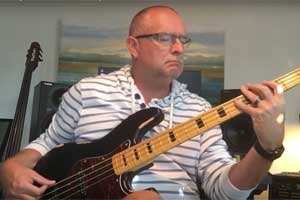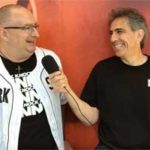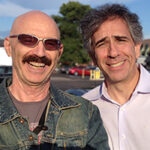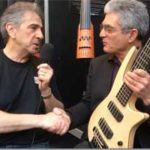From Randy Brecker and Larry Carlton to Billy Ray Cyrus and the Oakridge Boys, this musical powerhouse has done it all!
By Mindy Rochwerg
February 18, 2015
Hailing from Chattanooga, TN, Sean O’Bryan Smith is a world-renowned bassist, recording artist, film composer, producer, clinician and writer. Throughout the course of his decades-long career, Sean has performed and/or recorded with a wide variety of artists, cutting across all musical genres. The list ranges from jazz icons Randy Brecker, Chuck Loeb, Esperanza Spalding, Larry Carlton, Brian Bromberg, Gerald Albright, Victor Wooten, Frank Catalano and Rick Braun to pop and country artists Keith Urban, Darius Rucker, Kenny Rogers, Wynonna, Billy Currington, Lady Antebellum, Rascal Flatts, Billy Ray Cyrus, the Oak Ridge Boys and many others.
Sean has also released several albums as a leader. His recordings have been graced by the likes of Jeff “Skunk” Baxter, Jerry Marotta, Ken Rarick and many other top-level musicians.
Speaking recently to FBPO’s Jon Liebman, Smith described his upbringing and how his family surrounded him with music, virtually from the very beginning. “It was a healthy musical environment for sure,” says Sean. “My mother was a professional jazz and blues vocalist and would sing and play piano almost every night. One of my uncles was also a professional guitarist, so there were always (musical) influences around. The good part, too, was that the record player was always spinning. My oldest sister had an extensive album collection, which helped plant the seed for me. It was a neat time, since everything from Beethoven to Ray Charles to Pink Floyd could be heard at any given moment.”
Though he started on the drums, Smith was inspired to play bass after hearing Donald “Duck” Dunn, “Ready Freddie” Washington – on Michael Jackson’s Thriller – and James Jamerson. Marcus Miller and Jaco also had “significant impact,” but the two bassists that had the most influence on his developing style were Mark King and Vail Johnson, the latter being a good friend of Smith’s, who sits in with his band from time to time.
For fretless, it was Mark Egan and Pino Palladino and for the upright, Smith says, “it is mainly about Ron Carter.” Sean also cites Tony Levin as having had significant impact on the playing of all of his instruments.
Sean started playing professionally with his band director’s jazz group at the age of 15. Since then, he’s done everything from jazz and hip-hop gigs to recording sessions, composing, producing and more.
Describing his career as “musically bizarre,” Smith has an extensive track record, not only as a sideman, but as a solo artist as well. “I’ve continued that part of my multi-tiered life, with singles charting worldwide and numerous releases.” He’s currently in production for three full-length albums and numerous singles.
Despite keeping plenty busy playing bass and producing records, Smith’s “primary focus,” he says, is film scoring. “It is, without a doubt, the most musically freeing thing I’ve ever done and it has always been the finish line for my career. Most people don’t know, but I spent as much time listening to classical and film scores growing up as I did bass albums. John Williams and John Barry in particular just amazed me. I knew it was something I always wanted to do eventually. A few years back, a director called me out and said ‘prove it’ and commissioned a full orchestral piece for a trailer that I had to knock out in three days. I handed him a 200-piece orchestra battle scene epic and never looked back.”
Sean has since scored films in Canada, India and the U.S. He has also had a film premiere at the Cannes festival, a distinction he’s scheduled to repeat this spring. Smith is “currently attached” to nearly a dozen film projects on which he will be working throughout 2015 and 2016.
Sean says his experience as a bass player actually helped make him better at film scoring, drawing a parallel to the bass player’s traditionally supportive role. “It is all about supporting the scene and, when writing orchestral music, each instrument must support the others. I’m not formally trained, so that background is crucial to my success in film.”
When it comes to playing bass, Sean’s NS Design bass is a prominent force in his arsenal of gear and he relies on it “heavily.” Smith is especially appreciative of the company’s founder, Ned Steinberger, and the long track record the two men share. “I’ve worked with Ned since my Billy Ray (Cyrus) days and he’s been very good to me. I’ve used an NXT5 of his for a number of years now on countless tours and albums.”
Smith also uses a ’65 Ernst Heinrich Roth from Germany that rarely leaves the studio, as well as an 8-string bass by Ergo Instruments, affectionately known as his “freak” electric upright.
Amps vary, depending on the gig. Sean’s main recording and live rig centers around his Shaw Audio S.O.S. model bass preamp and an assortment of Ampeg gear. His effects include a collection of Mooer Audio, Tech 21, and Radial Engineering products, as well as a signature bass phaser, built by Noise Toy Pedals.
When not working on film scores or his own material, Sean somehow finds time to produce artists in the U.K. and Italy. He also tours with guitarists Joe Taylor and Neil Zaza and new country artist Shelly Waters and will be consumed by “everything from orchestra to electronica” in the coming months. “I’m actually pretty blessed in that I’ve achieved most of my major goals.”
Sean is still very a much a bass player at heart. “I think for the future, it is going to be more about returning to my primal love for the instrument and exploring some new musical and sonic ideas. I have some new ideas that I haven’t seen in the bass realm yet that I’m looking to perfect.”
So what would he be if he weren’t making music? “An architect,” replied the ever-creative Smith. “I love old and new buildings and great designs. I’m pretty sure I’d be a kid in a candy store in that world and it would feed my creative mind. I’d either do that or restore old cars. Luckily, I’ve done that already and will do it again if I ever learn to slow down.”





